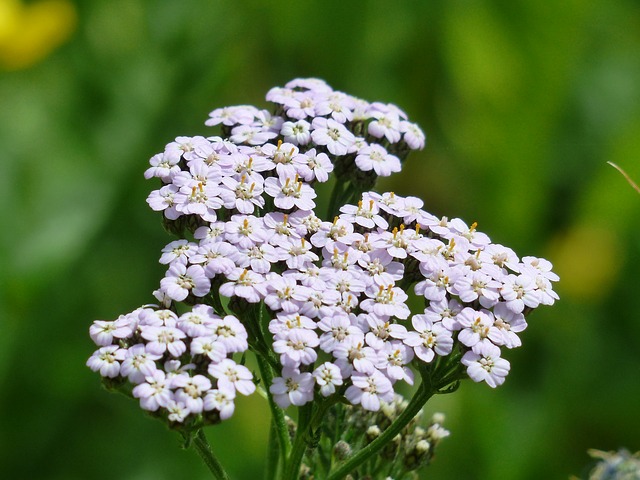 |  |  |  |  |
 |  |  |  |
Yarrow - a perennial medicinal plant with a height of 20-80 cm, endowed with a peculiar smell, with a creeping root, with little branched roots and an above-ground part. A stem grows from the rhizome, straight or slightly raised and slightly branched at the top.
The inflorescence consists of many small flowers in a box, which are placed like a shield at the top of the stem. Flowers usually have white petals, rarely pink. The fruit is a seed length of 1.5-2mm, stretched, compressed, without fluff, silver-gray in color. Yarrow blooms from July to late autumn, seeds begin to form from August.
The above-ground part of yarrow (Millefolii herba) is used for medicinal purposes. The plants are collected from the beginning of flowering until approximately the middle of the flowering period (July-August). Collect the tops of the stems together with the flowers, about 15 cm long, without the rough bases of the stems. Before drying, only inflorescences of 2-4 cm long stems are cut from the stems and dried on sieves or in a dryer not exceeding 50C.
Yarrow is included in the official medicine of many countries - Netherlands, Switzerland, Sweden, Finland, Australia, Romania, etc.
Ārstnieciskā nozīme
Pelašķim piemīt hemostatiskas (asins apturošas) un
pretiekaisuma īpašības.
Asins apturošas īpašības atgādina kalcija
jonus asinsreces procesā. hemostatiskās īpašības augā nodrošina K vitamīna klātesamība.
Asins apturošās īpašības nodrošina arī alfa filohinons un alkaloīds
ahileīns. Taču patiesais pelašķa asins apturošais efekts līdz galam vēl nav
izpētīts, jo pelašķis neveicina trombu veidošanos. Pelašķa fitopreparātu
iedarbība uz hemokoagulācijas procesu ir vienmērīga un novērojama tikai pie
ilglaicīgas to lietošanas, kā iekšķīgi, tā ārīgi.
Rūgtvielas (seskviterpenoīdie laktoni un ahileīns)
kairina garšas nervu galus, rosina apetīti un pastiprina kuņģa sekrēciju. Tai
pat laikā pastiprina žults izdali un aizkuņģa dziedzera iekšējās sekrēcijas
funkciju. Normalizē kuņģa un zarnu trakta motoriku, mazina meteorismu. Žulti
dzenošās īpašības, pelašķa preparātiem, saistās arī ar nepiesātinātām
taukskābēm, steroliem un triterpēnu glikozīdiem.
Flavonoīdi un ēteriskās eļļas iedarbojas
spazmolītiski uz zarnu gludo muskulatūru, urīna izvada kanāliem un žults
ceļiem. Tie paplašina žults ceļus, kā arī palielina diurēzi un spēj notrulināt
sāpes, kuras rada zarnu spazmas.
Miecvielas, cineols un azulēni rada pretiekaisuma,
baktericīdu, pret alerģijas un brūču dziedējošu efektu.
Pelašķa ēteriskā eļļa rada antibakteriālu un
pretsēnīšu iedarbību. Tā apsiež baktēriju augšanu, kuras ir izturīgas pret
antibiotiku iedarbību.
Tautas medicīnā pelašķis ir pazīstams kā organismu
spēcinošs un nomierinošs līdzeklis, kuram piemīt urīna un sviedru dzenoša
iedarbība. To izmanto, lai ārstētu dispepsiju, caureju, kuņģa un zarnu
saslimšanas, nieru un urīnceļu iekaisumus, nierakmeņu slimību, nakts
nesaturēšanu, nakts polūciju, ginekoloģiskus iekaisumus, kā arī malāriju,
izmanto arī menstruālā cikla regulēšanai un laktācijas stimulācijai un kā
prethelmintu līdzekli.
Svaigu pelašķa sulu kopā ar medu lieto, lai
uzlabotu apetīti, tuberkulozes, anēmijas un aknu slimību gadījumā.
Iekšķīgi pelašķi lieto reiboņu, sliktas dūšas, galvas sāpju, bezmiega,
histēriju, artrītu, neiralģijas gadījumā.
Pelašķa novārījumu var
pielietot vannās, lai ārstētu dažāda veida kašķi. Tas pielietojams arī kā ādas
kopjoš līdzeklis.
Vīriešiem
Pelašķi izmanto, lai mazinātu nakts pollūcijas un urīna izvades sistēmas iekaisumus. Maisījumos ar citiem augiem to izmanto, lai ārstētu prostatas adenomu, neauglību, impotenci, prostatītu, cistītu, tāpat to izmanto, lai uzlabotu erekcijas kvalitāti un novērstu pāragru sēklas noplūdi.
